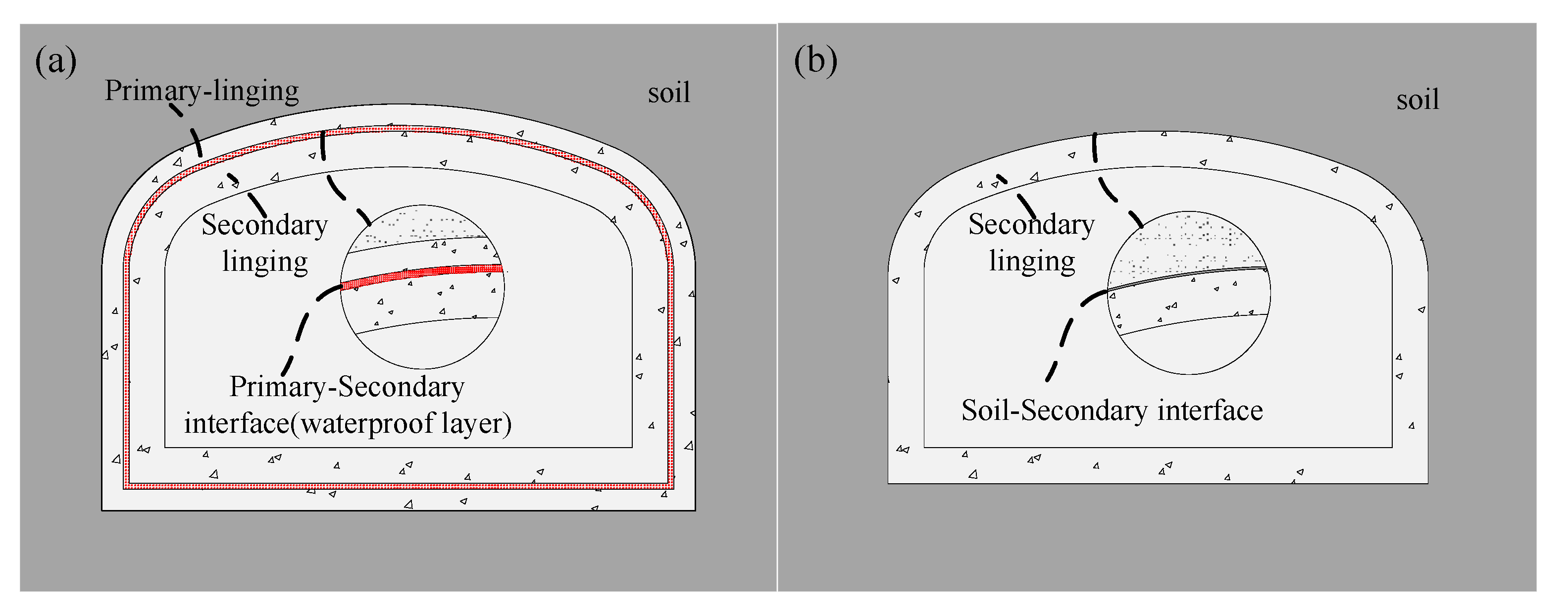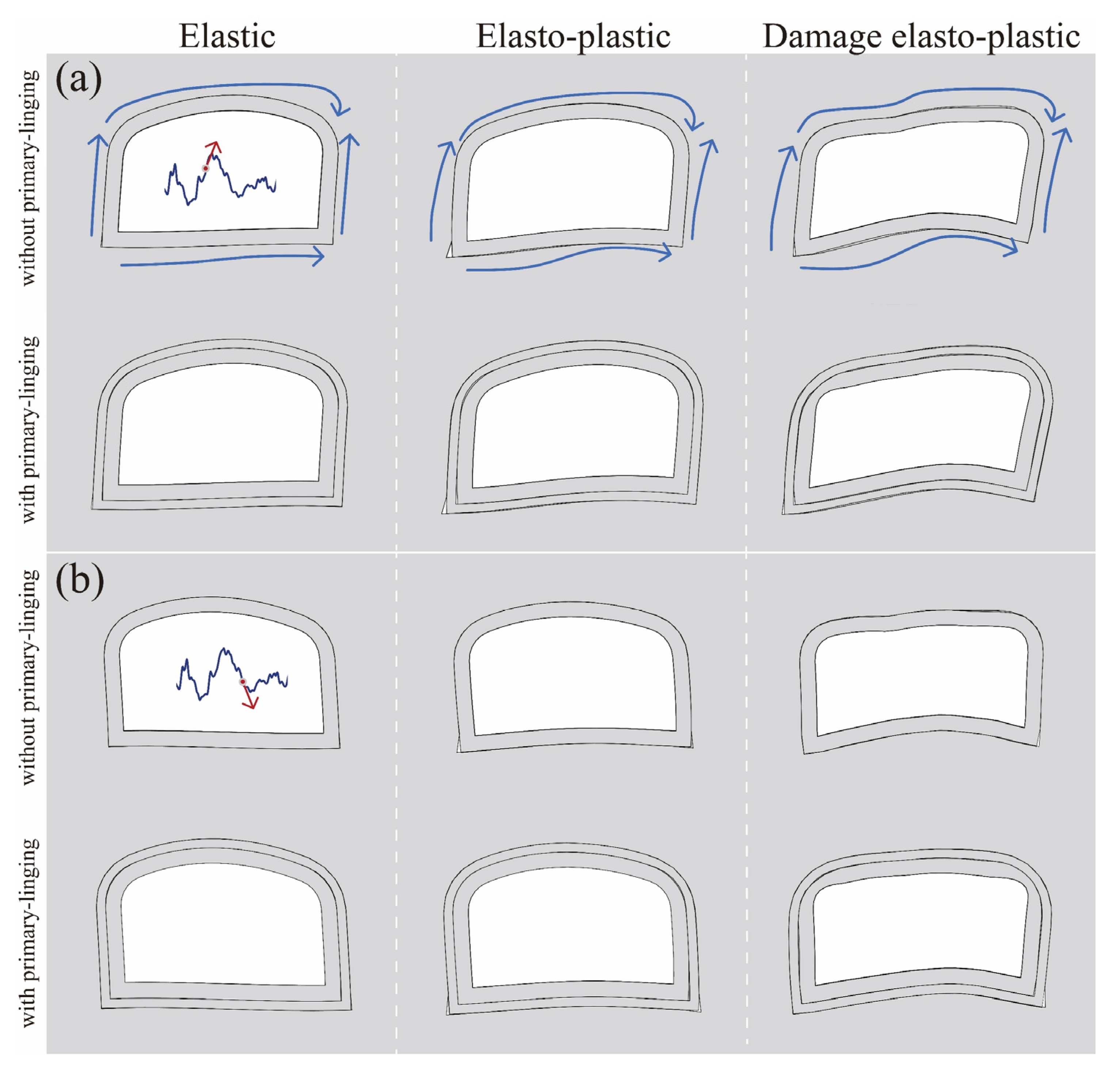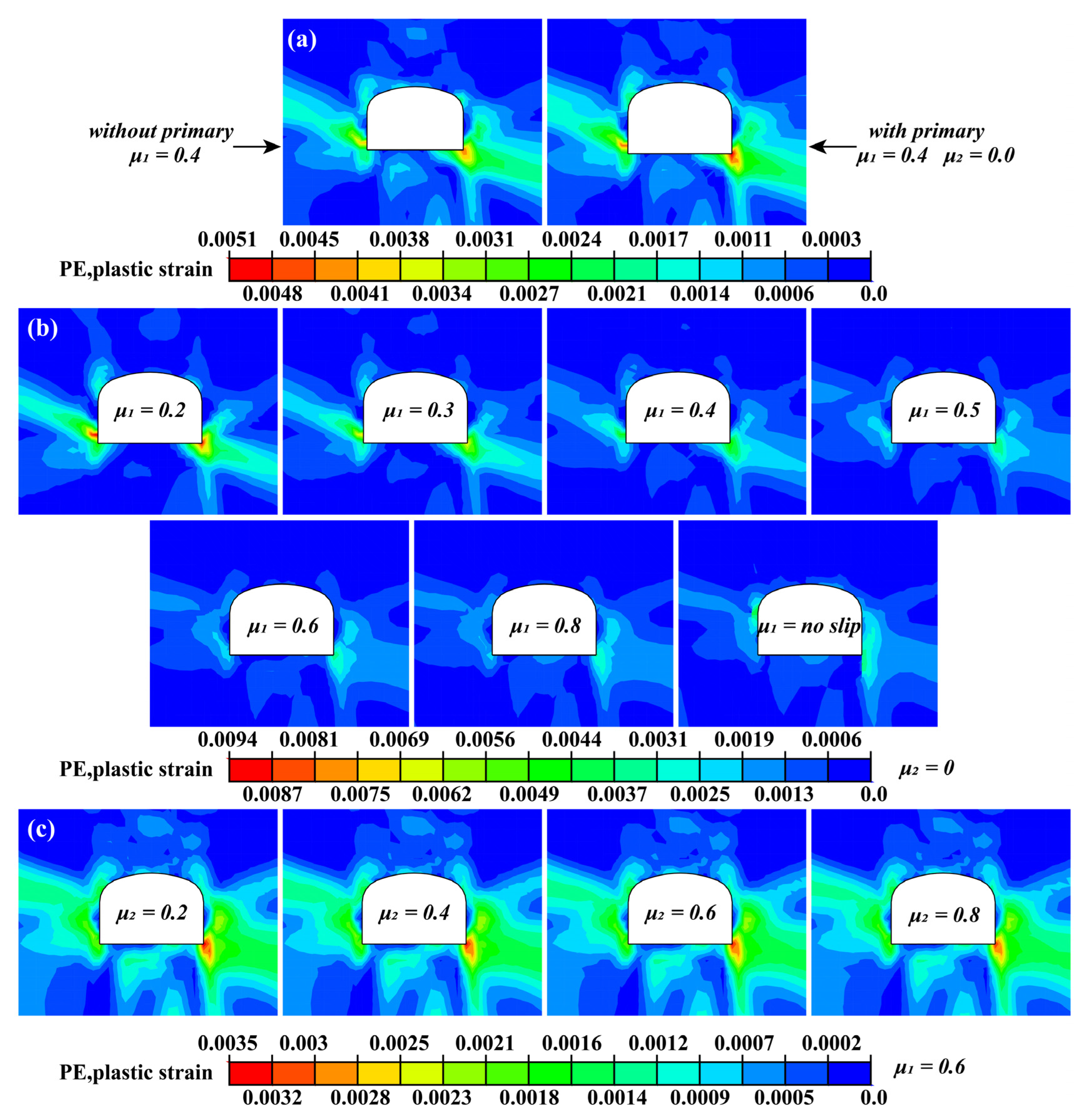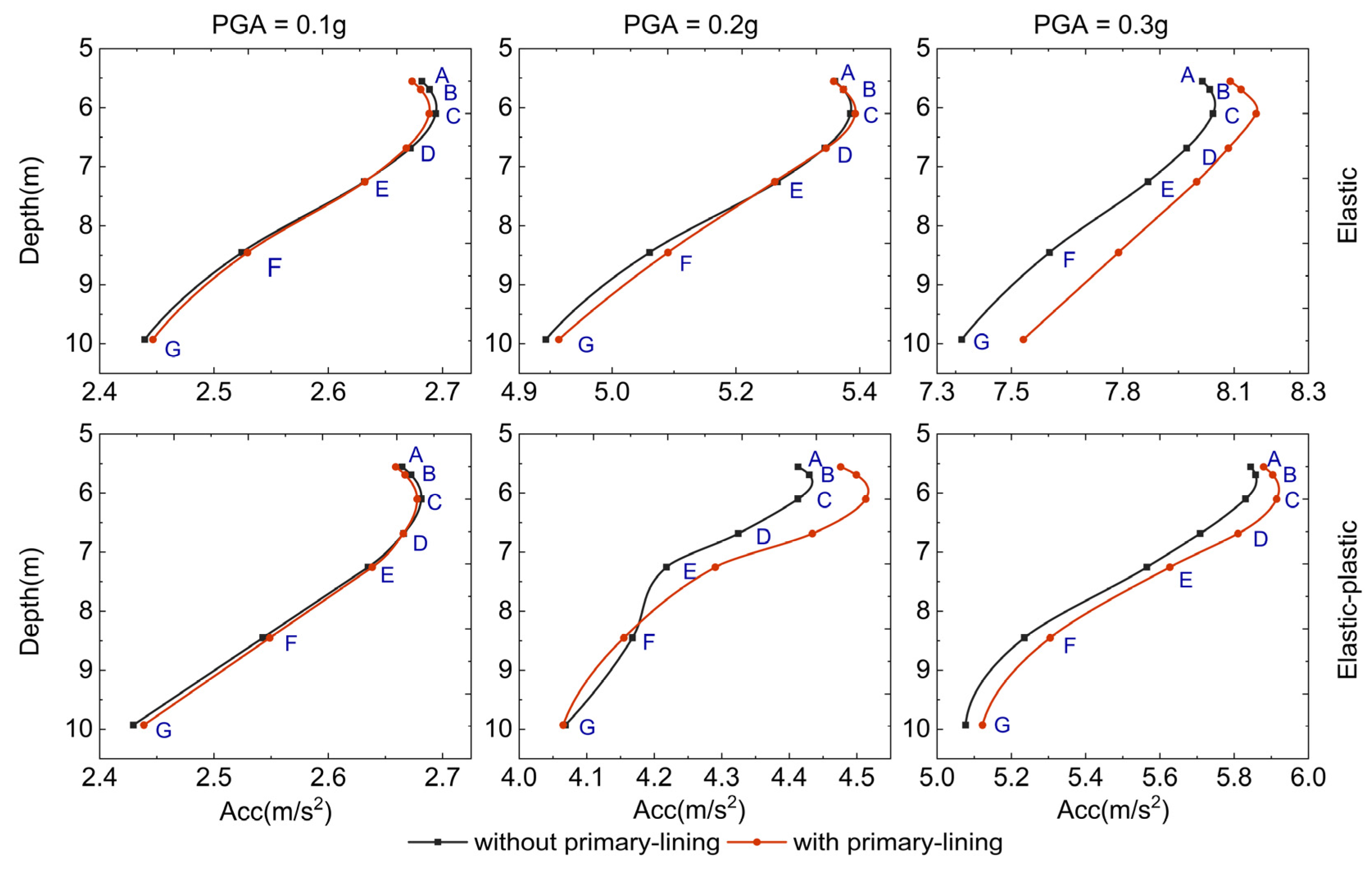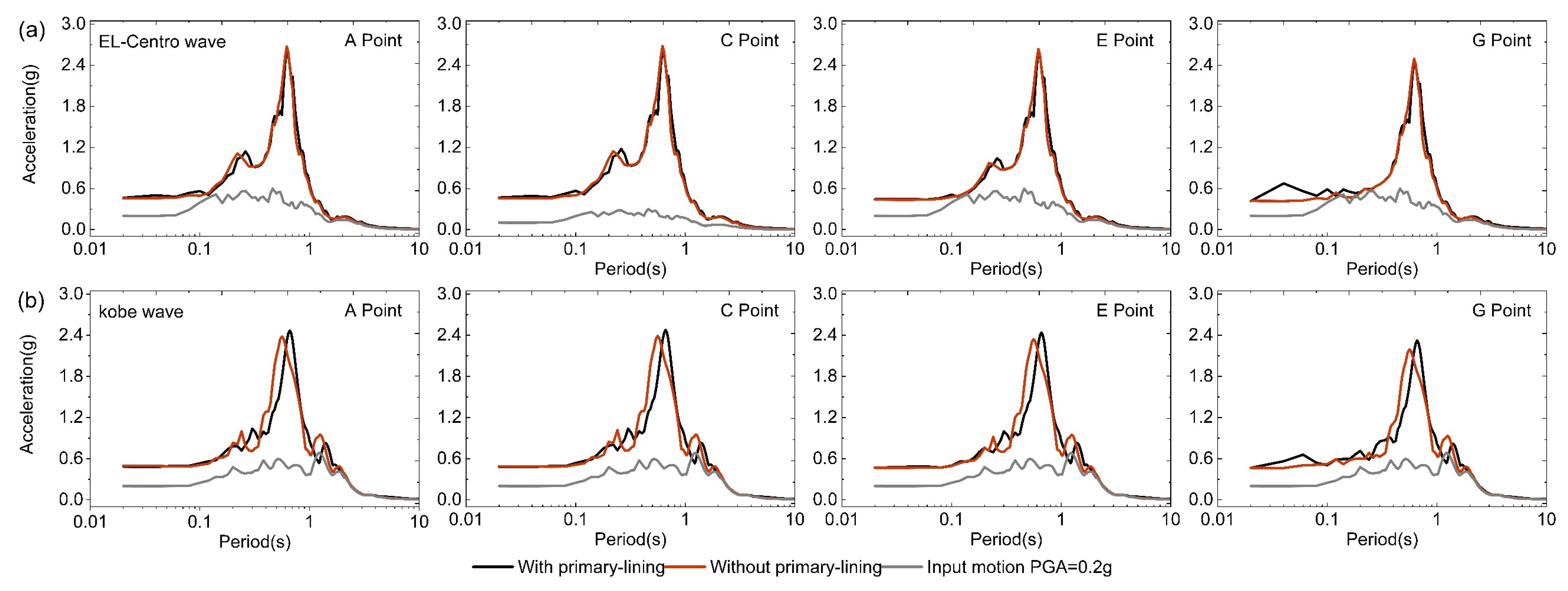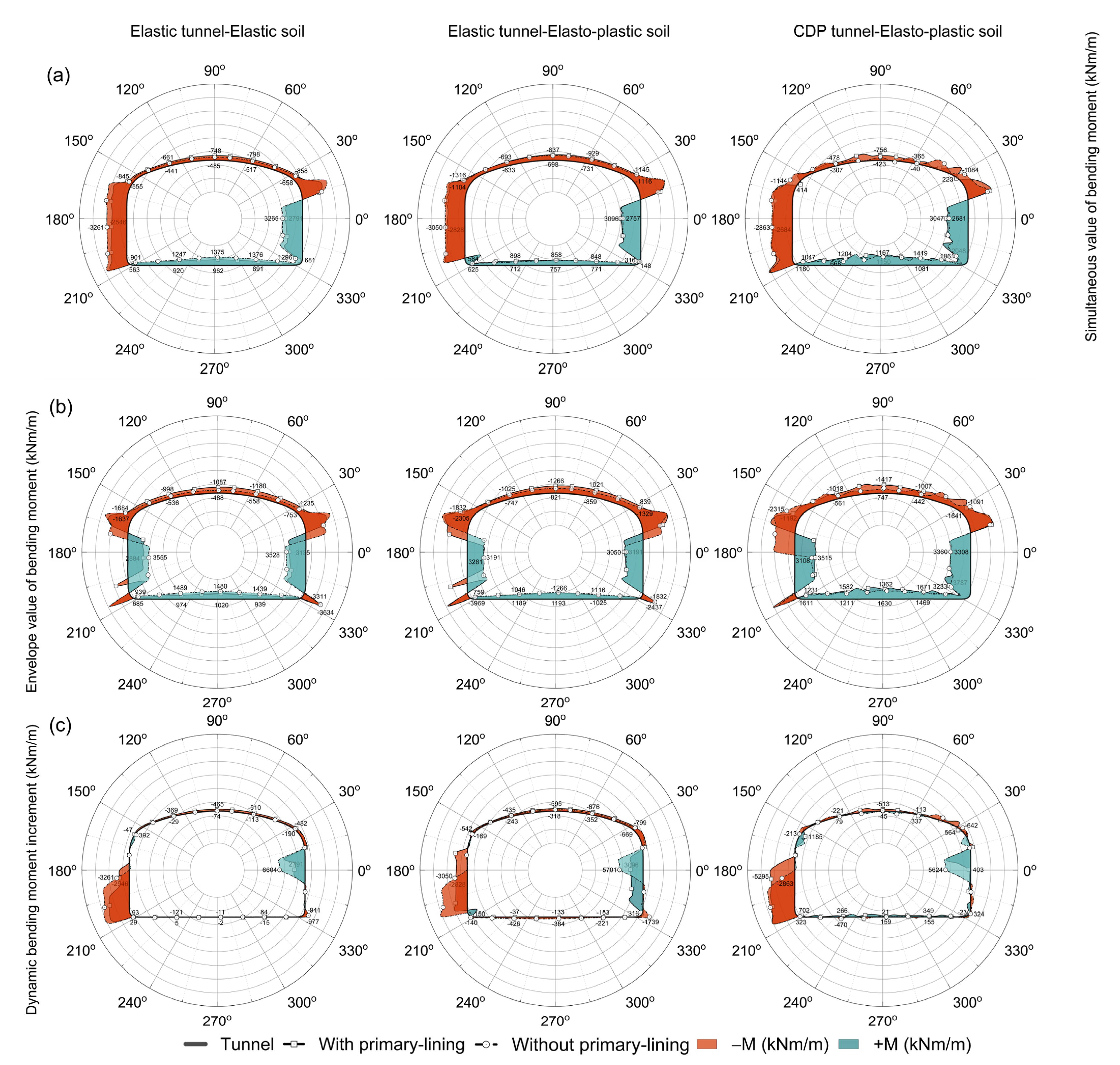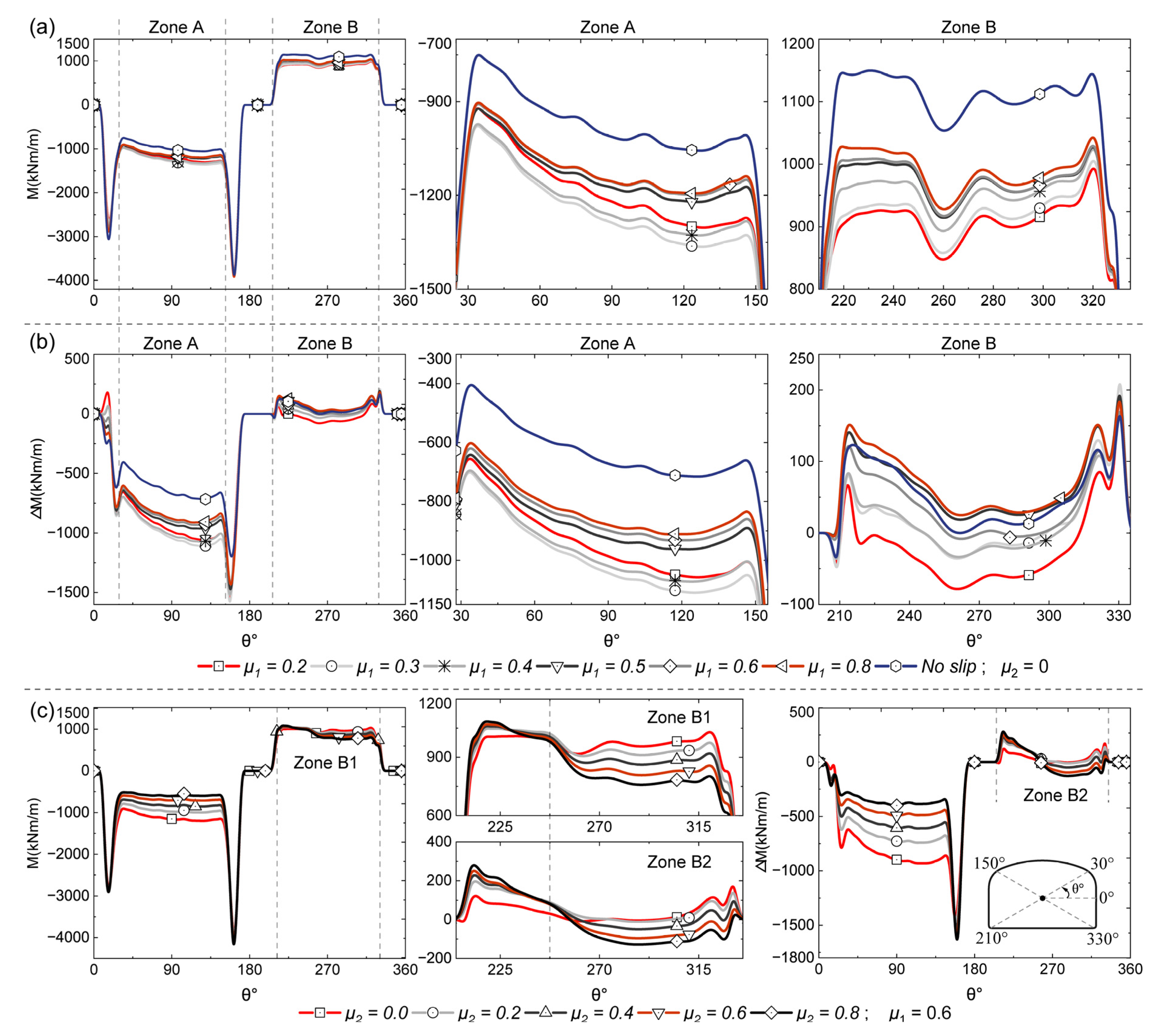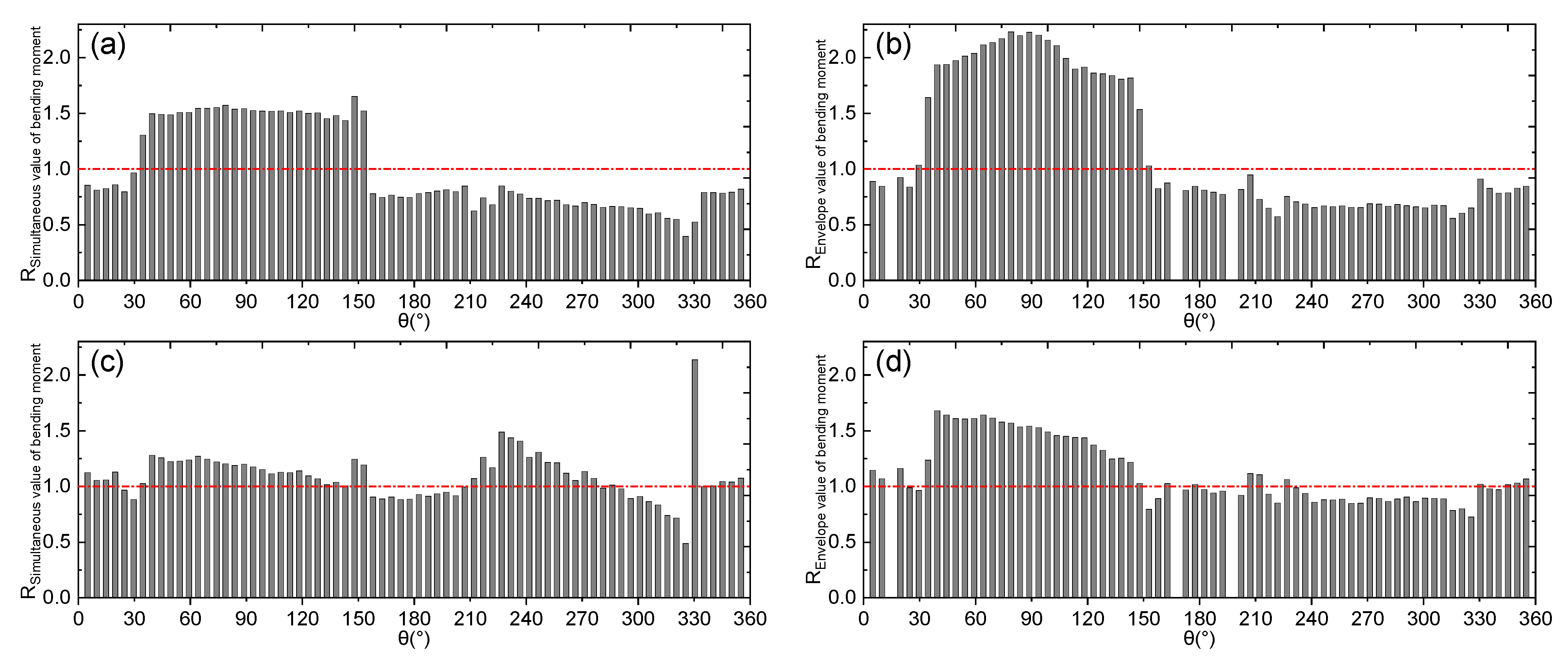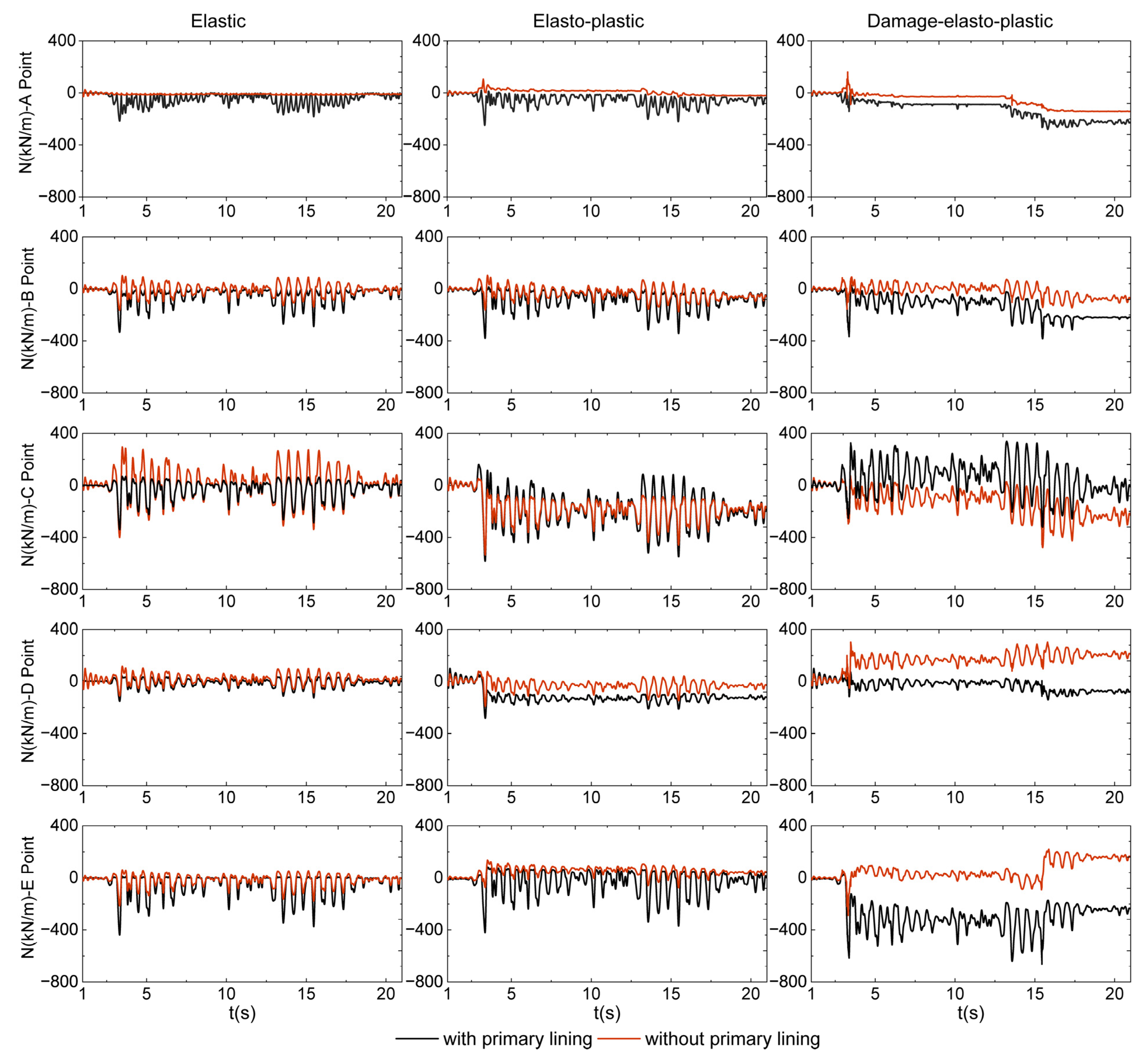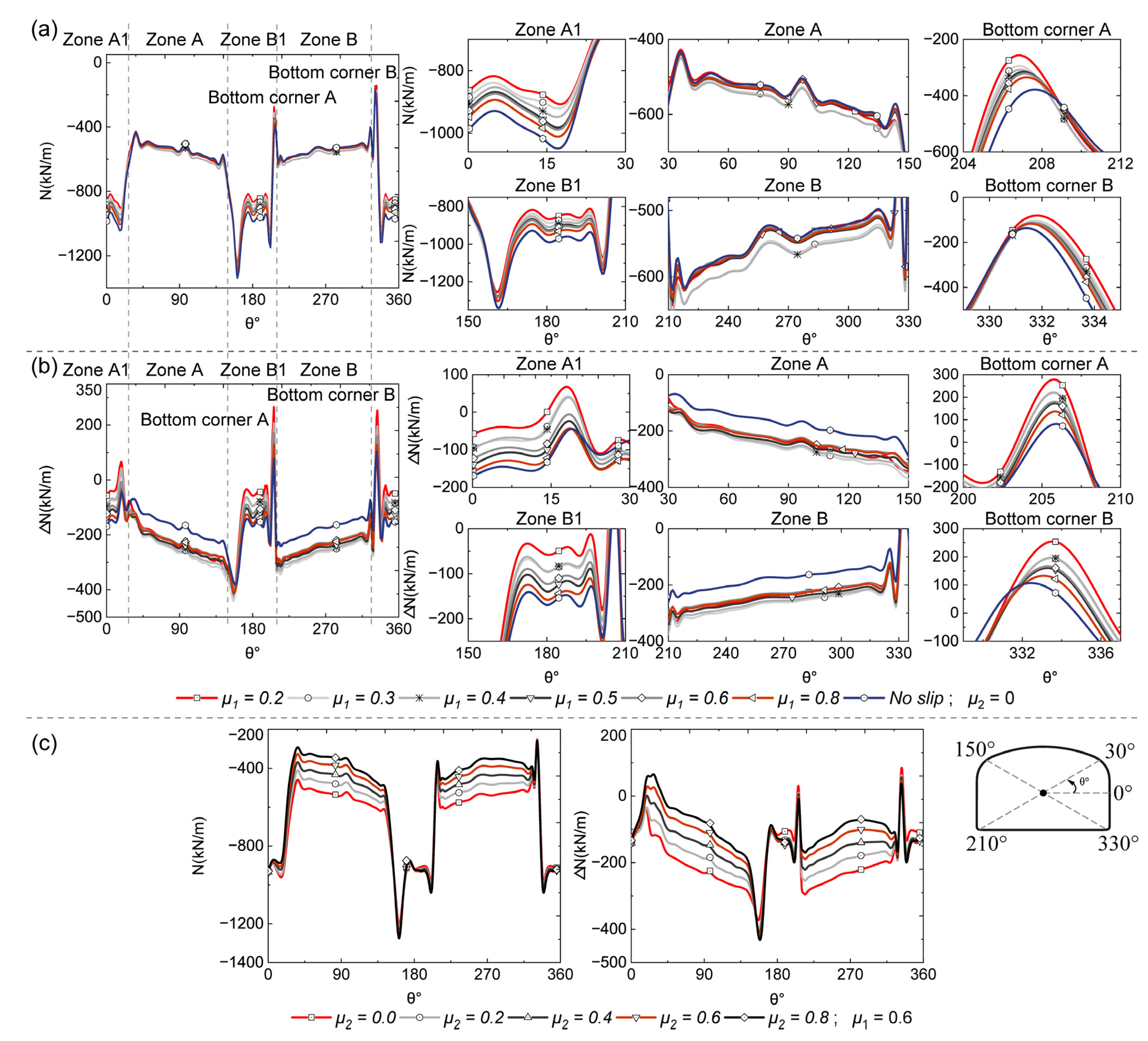Figure 1.
Tunnel configuration (a) distribution of soil layers (b) the direction of the longitudinal axis of the tunnel (c) the shape of tunnel section (d) reinforcement configuration of tunnel.
Figure 1.
Tunnel configuration (a) distribution of soil layers (b) the direction of the longitudinal axis of the tunnel (c) the shape of tunnel section (d) reinforcement configuration of tunnel.
Figure 2.
2D Finite element model (a) tunnel with primary lining (b) tunnel without primary lining (c) soil-tunnel model layout.
Figure 2.
2D Finite element model (a) tunnel with primary lining (b) tunnel without primary lining (c) soil-tunnel model layout.
Figure 3.
Full dynamic time analysis.
Figure 3.
Full dynamic time analysis.
Figure 4.
Sensitivity analysis for shear step and boundary condition modulus varying with depth.
Figure 4.
Sensitivity analysis for shear step and boundary condition modulus varying with depth.
Figure 5.
Contact interface schematic (a) with primary lining (b) without primary lining.
Figure 5.
Contact interface schematic (a) with primary lining (b) without primary lining.
Figure 6.
(a) Time histories of the input motions (PGA scaled to 0.1 g, 0.2 g, and 0.3 g) (b) acceleration response spectra of the input motions and design response spectrum of soil type II in GB50011-2010 (c) displacement response spectra of the input motions.
Figure 6.
(a) Time histories of the input motions (PGA scaled to 0.1 g, 0.2 g, and 0.3 g) (b) acceleration response spectra of the input motions and design response spectrum of soil type II in GB50011-2010 (c) displacement response spectra of the input motions.
Figure 7.
The shape of the deformed tunnel for time steps of the computed maximum distortion, elasto-plastic analysis: (a) ground motion towards the right (b) ground motion towards left; (deformations scale 100).
Figure 7.
The shape of the deformed tunnel for time steps of the computed maximum distortion, elasto-plastic analysis: (a) ground motion towards the right (b) ground motion towards left; (deformations scale 100).
Figure 8.
Vertical displacement of the tunnel with primary lining (a1–a4) time histories (b) monitoring stations (c) time histories of the vertical displacement of the tunnel crown.
Figure 8.
Vertical displacement of the tunnel with primary lining (a1–a4) time histories (b) monitoring stations (c) time histories of the vertical displacement of the tunnel crown.
Figure 9.
The shape of deformed tunnel for time steps computed.
Figure 9.
The shape of deformed tunnel for time steps computed.
Figure 10.
Soil plastic strain distributions (a) tunnels without and with primary lining (b) tunnels with primary lining; μ1 = 0.2, 0.4, 0.6, 0.8 and no-slip; μ2 = 0 (c) tunnels with primary lining; μ1 = 0.6; μ2 = 0.2, 0.4, 0.6, 0.8.
Figure 10.
Soil plastic strain distributions (a) tunnels without and with primary lining (b) tunnels with primary lining; μ1 = 0.2, 0.4, 0.6, 0.8 and no-slip; μ2 = 0 (c) tunnels with primary lining; μ1 = 0.6; μ2 = 0.2, 0.4, 0.6, 0.8.
Figure 11.
The response ratios of the oblique reference line CF and the line HE, and the angle θ.
Figure 11.
The response ratios of the oblique reference line CF and the line HE, and the angle θ.
Figure 12.
Horizontal acceleration amplification along the tunnel.
Figure 12.
Horizontal acceleration amplification along the tunnel.
Figure 13.
Acceleration response spectra at the important section of tunnel.
Figure 13.
Acceleration response spectra at the important section of tunnel.
Figure 14.
(a) sign convention of internal forces (b) time histories monitoring positions of the tunnel (c) the angle of the tunnel position relative to the center of the tunnel.
Figure 14.
(a) sign convention of internal forces (b) time histories monitoring positions of the tunnel (c) the angle of the tunnel position relative to the center of the tunnel.
Figure 15.
Dynamic bending moment time histories at the crucial section of tunnel (A/B/C/D/E) computed for EQ1. First column: elastic analysis result. Second column: elasto-plastic analysis result. Third column: damage plastic analysis result.
Figure 15.
Dynamic bending moment time histories at the crucial section of tunnel (A/B/C/D/E) computed for EQ1. First column: elastic analysis result. Second column: elasto-plastic analysis result. Third column: damage plastic analysis result.
Figure 16.
Bending moment distributions computed along the perimeter of the tunnel for EQ1: (a) simultaneous value of bending moment, (b) envelope value of bending moment, (c) dynamic bending moment increment of the maximum positive (+X) shear deformation.
Figure 16.
Bending moment distributions computed along the perimeter of the tunnel for EQ1: (a) simultaneous value of bending moment, (b) envelope value of bending moment, (c) dynamic bending moment increment of the maximum positive (+X) shear deformation.
Figure 17.
Effect of interface characteristics on bending moment (a) tunnels without and with primary lining (b) tunnels with primary lining; μ1 = 0.2, 0.4, 0.6, 0.8 and no-slip; μ2 = 0 (c) tunnels with primary lining; μ1 = 0.6; μ2 = 0.2, 0.4, 0.6, 0.8.
Figure 17.
Effect of interface characteristics on bending moment (a) tunnels without and with primary lining (b) tunnels with primary lining; μ1 = 0.2, 0.4, 0.6, 0.8 and no-slip; μ2 = 0 (c) tunnels with primary lining; μ1 = 0.6; μ2 = 0.2, 0.4, 0.6, 0.8.
Figure 18.
Dynamic response ratio of the bending moment. First row (a,b): elastic analysis result. Second row (c,d): elasto-plastic analysis result. Third row (e,f): damage plastic analysis result.
Figure 18.
Dynamic response ratio of the bending moment. First row (a,b): elastic analysis result. Second row (c,d): elasto-plastic analysis result. Third row (e,f): damage plastic analysis result.
Figure 19.
Dynamic axial force time histories at crucial sections of tunnel (A/B/C/D/E) computed for EQ1. First column: elastic analysis result. Second column: elasto-plastic analysis result. Third column: damage plastic analysis result.
Figure 19.
Dynamic axial force time histories at crucial sections of tunnel (A/B/C/D/E) computed for EQ1. First column: elastic analysis result. Second column: elasto-plastic analysis result. Third column: damage plastic analysis result.
Figure 20.
Axial force distributions computed along the perimeter of the tunnel for EQ1: (a) simultaneous value of axial force, (b) envelope value of axial force, (c) dynamic axial force increment of the maximum positive (+X) shear deformation.
Figure 20.
Axial force distributions computed along the perimeter of the tunnel for EQ1: (a) simultaneous value of axial force, (b) envelope value of axial force, (c) dynamic axial force increment of the maximum positive (+X) shear deformation.
Figure 21.
Effect of interface characteristics on axial force (a) tunnels without and with primary lining (b) tunnels with primary lining; μ1 = 0.2, 0.4, 0.6, 0.8 and no-slip; μ2 = 0 (c) tunnels with primary lining; μ1 = 0.6; μ2 = 0.2, 0.4, 0.6, 0.8.
Figure 21.
Effect of interface characteristics on axial force (a) tunnels without and with primary lining (b) tunnels with primary lining; μ1 = 0.2, 0.4, 0.6, 0.8 and no-slip; μ2 = 0 (c) tunnels with primary lining; μ1 = 0.6; μ2 = 0.2, 0.4, 0.6, 0.8.
Figure 22.
Dynamic response ratio of the axial force. First row (a,b): elastic analysis result. Second row (c,d): elasto-plastic analysis result. Third row (e,f): damage plastic analysis result.
Figure 22.
Dynamic response ratio of the axial force. First row (a,b): elastic analysis result. Second row (c,d): elasto-plastic analysis result. Third row (e,f): damage plastic analysis result.
Figure 23.
Seismic tensile damage of tunnel with PGA = 0.1 g, 0.2 g, 0.3 g (a) EL-Centro Wave (b) Kobe wave.
Figure 23.
Seismic tensile damage of tunnel with PGA = 0.1 g, 0.2 g, 0.3 g (a) EL-Centro Wave (b) Kobe wave.
Table 1.
Tunnel mechanics parameters.
Table 1.
Tunnel mechanics parameters.
| Tunnel Lining | Density (kg /m3) | Elastic Modulus (GPa) | Poisson Ratio |
|---|
| primary lining (C25) | 2500 | 25.5 | 0.2 |
| secondary lining (C35) | 2500 | 32.5 | 0.2 |
Table 2.
Soil mechanics parameters.
Table 2.
Soil mechanics parameters.
| Soil Stratum | Density (g/cm3) | Void Ratio | Poisson Ratio | Cohesion (kPa) | Friction Angle (°) | Shear Wave Velocity (m/s) |
|---|
| plain fill①2 | 1.82 | / | 0.25 | / | / | 188.30 |
| silty sand③43 | 1.92 | 0.60 | 0.30 | 3 | 34 | 253.10 |
| medium dense sand③63 | 1.98 | 0.61 | 0.28 | 0 | 38 | 257.5 |
| gravel sand③83 | 2.02 | 0.61 | 0.25 | 0 | 35 | 311.75 |
| silty clay③2 | 1.99 | 0.746 | 0.30 | 20 | 28.5 | 321.75 |
| silty sand③43 | 1.92 | 0.61 | 0.30 | 3 | 34 | 340.4 |
| gravel sand③84 | 2.02 | 0.51 | 0.25 | 0 | 35 | 416.6 |
| silty clay④2 | 1.97 | 0.762 | 0.26 | 29.7 | 22.6 | 384.6 |
Table 3.
Numerical cases for dynamic response.
Table 3.
Numerical cases for dynamic response.
| Case Name | Soil | Concrete | Steel |
|---|
| Elastic | Visco-elastic | Elastic | Elastic |
| Elasto-plastic | Visco-elastic-plastic | Elastic | Elastic |
| Damage elasto-plastic | Visco-elastic-plastic | Damaged-plasticity | Elastic |
Table 4.
Relationship of compressive stress, plastic strain, and damage factor of concrete(c25).
Table 4.
Relationship of compressive stress, plastic strain, and damage factor of concrete(c25).
| Plastic strain (%) | 0.000 | 0.014 | 0.020 | 0.029 | 0.054 | 0.100 | 0.128 | 0.154 | 0.180 | 0.208 | 0.238 | 0.270 | 0.307 | 0.348 | 0.396 | 0.453 | 0.523 | 0.611 |
| Comp. stress (MPa) | 10.03 | 14.26 | 15.10 | 15.94 | 16.70 | 15.86 | 15.02 | 14.18 | 13.34 | 12.50 | 11.67 | 10.83 | 9.99 | 9.15 | 8.31 | 7.48 | 6.64 | 5.81 |
| dc | 0.000 | 0.089 | 0.125 | 0.172 | 0.275 | 0.417 | 0.482 | 0.534 | 0.581 | 0.623 | 0.662 | 0.699 | 0.733 | 0.766 | 0.798 | 0.827 | 0.856 | 0.882 |
Table 5.
Relationship of tensile stress, cracking strain, and damage factor of concrete(c25).
Table 5.
Relationship of tensile stress, cracking strain, and damage factor of concrete(c25).
| Cracking strain (%) | 0 | 0.001 | 0.002 | 0.005 | 0.007 | 0.009 | 0.011 | 0.014 | 0.016 | 0.018 | 0.021 | 0.024 | 0.028 | 0.032 | 0.038 | 0.044 | 0.053 |
| Tens. stress (MPa) | 1.425 | 1.693 | 1.780 | 1.691 | 1.601 | 1.512 | 1.422 | 1.333 | 1.244 | 1.154 | 1.065 | 0.975 | 0.886 | 0.797 | 0.708 | 0.619 | 0.530 |
| dt | 0 | 0.019 | 0.055 | 0.202 | 0.284 | 0.353 | 0.416 | 0.473 | 0.527 | 0.578 | 0.626 | 0.672 | 0.716 | 0.758 | 0.797 | 0.835 | 0.870 |
Table 6.
Relationship of compressive stress, plastic strain, and damage factor of concrete(c35).
Table 6.
Relationship of compressive stress, plastic strain, and damage factor of concrete(c35).
| Plastic strain (%) | 0.000 | 0.010 | 0.014 | 0.029 | 0.056 | 0.095 | 0.117 | 0.158 | 0.179 | 0.202 | 0.252 | 0.282 | 0.316 | 0.355 | 0.403 | 0.461 | 0.537 | 0.640 |
| Comp. stress (MPa) | 14.07 | 18.80 | 19.97 | 22.32 | 23.40 | 22.22 | 21.05 | 18.69 | 17.51 | 16.34 | 13.99 | 12.82 | 11.64 | 10.46 | 9.28 | 8.11 | 6.93 | 5.76 |
| dc | 0.000 | 0.046 | 0.069 | 0.139 | 0.232 | 0.337 | 0.389 | 0.474 | 0.513 | 0.551 | 0.625 | 0.661 | 0.698 | 0.734 | 0.771 | 0.807 | 0.842 | 0.877 |
Table 7.
Relationship of tensile stress, cracking strain, and damage factor of concrete(c35).
Table 7.
Relationship of tensile stress, cracking strain, and damage factor of concrete(c35).
| Cracking strain (%) | 0.000 | 0.001 | 0.002 | 0.005 | 0.006 | 0.008 | 0.010 | 0.013 | 0.015 | 0.017 | 0.019 | 0.022 | 0.025 | 0.029 | 0.033 | 0.039 | 0.047 | 0.058 |
| Tens. stress (MPa) | 1.76 | 1.87 | 2.20 | 2.09 | 1.98 | 1.87 | 1.76 | 1.54 | 1.43 | 1.32 | 1.21 | 1.09 | 0.98 | 0.87 | 0.76 | 0.65 | 0.54 | 0.43 |
| dt | 0.000 | 0.015 | 0.059 | 0.167 | 0.229 | 0.284 | 0.335 | 0.433 | 0.481 | 0.528 | 0.575 | 0.622 | 0.668 | 0.714 | 0.760 | 0.805 | 0.848 | 0.890 |
Table 8.
Input seismic motion.
Table 8.
Input seismic motion.
| A/A | Earthquake Name | Date | Station Name | Magnitude Mw | PGA(g) |
|---|
| EQ1 | Imperial Valley | 19/5/1940 | El Centro Array #9 | 6.95 | 0.346 |
| EQ2 | Kobe | 16/1/1995 | Takatori | 6.9 | 0.61 |




